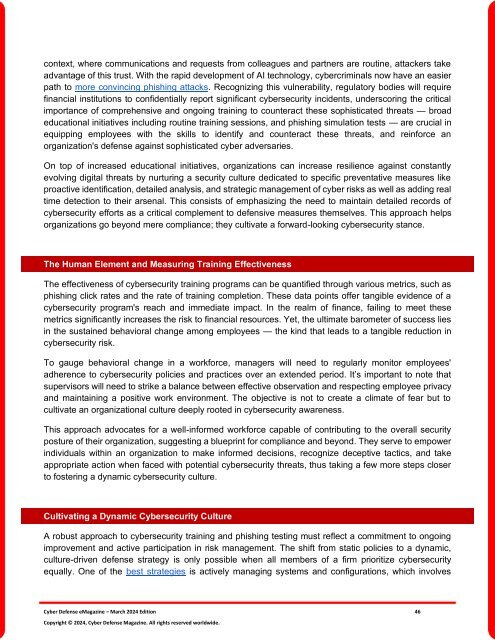The Cyber Defense eMagazine March Edition for 2024
Cyber Defense eMagazine March Edition for 2024 #CDM #CYBERDEFENSEMAG @CyberDefenseMag by @Miliefsky a world-renowned cyber security expert and the Publisher of Cyber Defense Magazine as part of the Cyber Defense Media Group as well as Yan Ross, Editor-in-Chief and many more writers, partners and supporters who make this an awesome publication! 225 page March Edition fully packed with some of our best content. Thank you all and to our readers! OSINT ROCKS! #CDM #CDMG #OSINT #CYBERSECURITY #INFOSEC #BEST #PRACTICES #TIPS #TECHNIQUES
Cyber Defense eMagazine March Edition for 2024 #CDM #CYBERDEFENSEMAG @CyberDefenseMag by @Miliefsky a world-renowned cyber security expert and the Publisher of Cyber Defense Magazine as part of the Cyber Defense Media Group as well as Yan Ross, Editor-in-Chief and many more writers, partners and supporters who make this an awesome publication! 225 page March Edition fully packed with some of our best content. Thank you all and to our readers! OSINT ROCKS! #CDM #CDMG #OSINT #CYBERSECURITY #INFOSEC #BEST #PRACTICES #TIPS #TECHNIQUES
Create successful ePaper yourself
Turn your PDF publications into a flip-book with our unique Google optimized e-Paper software.
context, where communications and requests from colleagues and partners are routine, attackers take<br />
advantage of this trust. With the rapid development of AI technology, cybercriminals now have an easier<br />
path to more convincing phishing attacks. Recognizing this vulnerability, regulatory bodies will require<br />
financial institutions to confidentially report significant cybersecurity incidents, underscoring the critical<br />
importance of comprehensive and ongoing training to counteract these sophisticated threats — broad<br />
educational initiatives including routine training sessions, and phishing simulation tests — are crucial in<br />
equipping employees with the skills to identify and counteract these threats, and rein<strong>for</strong>ce an<br />
organization's defense against sophisticated cyber adversaries.<br />
On top of increased educational initiatives, organizations can increase resilience against constantly<br />
evolving digital threats by nurturing a security culture dedicated to specific preventative measures like<br />
proactive identification, detailed analysis, and strategic management of cyber risks as well as adding real<br />
time detection to their arsenal. This consists of emphasizing the need to maintain detailed records of<br />
cybersecurity ef<strong>for</strong>ts as a critical complement to defensive measures themselves. This approach helps<br />
organizations go beyond mere compliance; they cultivate a <strong>for</strong>ward-looking cybersecurity stance.<br />
<strong>The</strong> Human Element and Measuring Training Effectiveness<br />
<strong>The</strong> effectiveness of cybersecurity training programs can be quantified through various metrics, such as<br />
phishing click rates and the rate of training completion. <strong>The</strong>se data points offer tangible evidence of a<br />
cybersecurity program's reach and immediate impact. In the realm of finance, failing to meet these<br />
metrics significantly increases the risk to financial resources. Yet, the ultimate barometer of success lies<br />
in the sustained behavioral change among employees — the kind that leads to a tangible reduction in<br />
cybersecurity risk.<br />
To gauge behavioral change in a work<strong>for</strong>ce, managers will need to regularly monitor employees'<br />
adherence to cybersecurity policies and practices over an extended period. It’s important to note that<br />
supervisors will need to strike a balance between effective observation and respecting employee privacy<br />
and maintaining a positive work environment. <strong>The</strong> objective is not to create a climate of fear but to<br />
cultivate an organizational culture deeply rooted in cybersecurity awareness.<br />
This approach advocates <strong>for</strong> a well-in<strong>for</strong>med work<strong>for</strong>ce capable of contributing to the overall security<br />
posture of their organization, suggesting a blueprint <strong>for</strong> compliance and beyond. <strong>The</strong>y serve to empower<br />
individuals within an organization to make in<strong>for</strong>med decisions, recognize deceptive tactics, and take<br />
appropriate action when faced with potential cybersecurity threats, thus taking a few more steps closer<br />
to fostering a dynamic cybersecurity culture.<br />
Cultivating a Dynamic <strong>Cyber</strong>security Culture<br />
A robust approach to cybersecurity training and phishing testing must reflect a commitment to ongoing<br />
improvement and active participation in risk management. <strong>The</strong> shift from static policies to a dynamic,<br />
culture-driven defense strategy is only possible when all members of a firm prioritize cybersecurity<br />
equally. One of the best strategies is actively managing systems and configurations, which involves<br />
<strong>Cyber</strong> <strong>Defense</strong> <strong>eMagazine</strong> – <strong>March</strong> <strong>2024</strong> <strong>Edition</strong> 46<br />
Copyright © <strong>2024</strong>, <strong>Cyber</strong> <strong>Defense</strong> Magazine. All rights reserved worldwide.

















